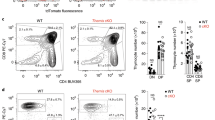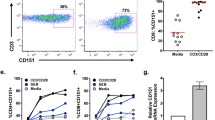Abstract
CD43 (sialophorin, leukosialin, leukocyte large sialoglyco-protein), a heavily sialylated molecule found on most leukocytes and platelets, was initially identified as a major glycoprotein of mouse, rat and human T cells1–8. CD43 expression is defective on the T cells of males with the Wiskott–Aldrich syndrome, an X chromosome-linked recessive immunodeficiency disorder9. Affected males are susceptible to opportunistic infections and do not respond to polysaccharide antigens, reflecting defects in cytotoxic and helper T-cell functions. Anti-CD43 monoclonal antibodies have a modest costimulatory effect on T cells, natural killer cells, B cells and monocytes10–14, and one such antibody has been shown to activate T cells directly15. To investigate a possible physiological role for CD43, a complementary DNA encoding the human protein16,17 was introduced into an antigen-responsive murine T-cell hybridoma18. We observed that CD43 enhances the antigen-specific activation of T cells and that the intracellular domain of CD43, which is hyperphosphorylated during T-cell activation19–21, is required for this function. We also found that antigen-presenting cells can bind specifically to immobilized purified CD43 and that the binding can be inhibited by liposomes containing CD43 as well as by anti-CD43 monoclonal antibodies.
This is a preview of subscription content, access via your institution
Access options
Subscribe to this journal
Receive 51 print issues and online access
$199.00 per year
only $3.90 per issue
Buy this article
- Purchase on Springer Link
- Instant access to full article PDF
Prices may be subject to local taxes which are calculated during checkout
Similar content being viewed by others
References
Gahmberg, C. G. & Andersson, L. C. J. biol. Chem. 252, 5888–5894 (1977).
Gahmberg, C. G., Hayry, P. & Andersson, L. C. J. Cell Biol. 68, 642–653 (1976).
Brown, W. R. A., Barclay, A. N., Sunderland, C. A. & Williams, A. F. Nature 289, 456–460 (1981).
Remold-O'Donnell, E., Davis, A. E., Kenney, D., Bhaskar, K. R. & Rosen, F. S. J. biol. Chem. 261, 7526–7530 (1986).
Carlsson, S. R. & Fukuda, M. J. biol. Chem. 261, 12779–12786 (1986).
Axelsson, B., Hammerstrom, S., Finne, J. & Perlmann, P. Eur. J. Immun. 15, 427–433 (1985).
Borche, L., Lozano, F., Vilella, R. & Vives, J. Eur. J. Immun. 17, 1523–1526 (1987).
Remold-O'Donnell, E., Zimmerman, C., Kenney, D. & Rosen, F. S. Blood 70, 104–109 (1987).
Parkman, R., Remold-O'Donnell, E., Kenney, D. M., Perrine, S. & Rosen, F. S. Lancet ii, 1387–1389 (1981).
Axelsson, B., Youseffi-Etemad, R., Hammerstrom, S. & Perlmann, P. J. Immun. 141, 2912–2917 (1988).
Vargas-Cortes, M., Axelsson, B., Larsson, A., Berzins, T. & Perlmann, P. Scand. J. Immun. 27, 661–671 (1988).
Beyers, A. D., Barclay, A. N., Law, D. A., He, Q. & Williams, A. F. Immun. Rev. 111, 59–77 (1989).
Nong, Y.-H., Remold-O'Donnell, E., LeBien, T. W. & Remold, H. G. J. exp. Med. 170, 259–267 (1989).
Wiken, M., Bjork, P., Axelsson, B. & Perlmann, P. Scand. J. Immun. 29, 363–370 (1989).
Mentzer, S. J. et al. J. exp. Med. 165, 1383–1392 (1987).
Pallant, A. et al. Proc. natn. Acad. Sci. U.S.A. 86, 1328–1332 (1989).
Shelley, C. S. et al. Proc. natn. Acad. Sci. U.S.A. 86, 2819–2823 (1989).
Sleckman, B. P. et al. Nature 328, 351–353 (1987).
Chatila, T. A. & Geha, R. S. J. Immun. 140, 4308–4314 (1988).
Axelsson, B. & Perlmann, P. Scand. J. Immun. 30, 539–547 (1989).
Piller, V., Piller, F. & Fukuda, M. J. biol. Chem. 264, 18824–18831 (1989).
Bierer, B. E., Sleckman, B. P., Ratnofsky, S. E. & Burakoff, S. J. A. Rev. Immun. 7, 579–599 (1989).
Springer, T. A. Nature 346, 425–434 (1990).
Ohashi, P. S. et al. Nature 316, 606–609 (1985).
Potter, H. in Current Protocols in Molecular Biology (eds Ausubel, F. M. et al.) 9.3.1–9.3.2 (Wiley, New York, 1987).
Takai, Y., Reed, M. L., Burakoff, S. J. & Herrmann, S. H. Proc. natn. Acad. Sci. U.S.A. 84, 6864–6868 (1987).
Author information
Authors and Affiliations
Rights and permissions
About this article
Cite this article
Park, J., Rosenstein, Y., Remold-O'Donnell, E. et al. Enhancement of T-cell activation by the CD43 molecule whose expression is defective in Wiskott–Aldrich syndrome. Nature 350, 706–709 (1991). https://doi.org/10.1038/350706a0
Received:
Accepted:
Issue Date:
DOI: https://doi.org/10.1038/350706a0
This article is cited by
-
Integration of genetic, transcriptomic, and clinical data provides insight into 16p11.2 and 22q11.2 CNV genes
Genome Medicine (2021)
-
Resistin reinforces interferon λ-3 to eliminate hepatitis C virus with fine-tuning from RETN single-nucleotide polymorphisms
Scientific Reports (2016)
-
CD43
AfCS-Nature Molecule Pages (2006)
-
Overexpression of leukocyte marker CD43 causes activation of the tumor suppressor proteins p53 and ARF
Oncogene (2004)
-
Reduced CD43 Expression on the Neutrophils of MDS Patients Correlates With an Activated Phenotype of These Cells
International Journal of Hematology (2001)
Comments
By submitting a comment you agree to abide by our Terms and Community Guidelines. If you find something abusive or that does not comply with our terms or guidelines please flag it as inappropriate.



